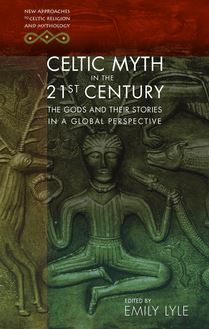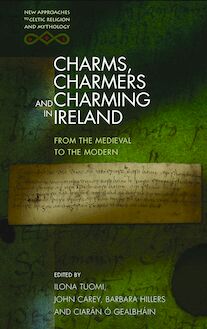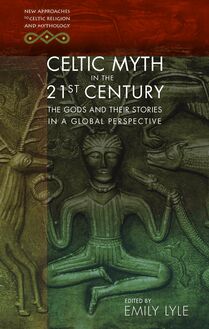Rethinking the Ancient Druids , livre ebook
125
pages
English
Ebooks
2021
Vous pourrez modifier la taille du texte de cet ouvrage
Obtenez un accès à la bibliothèque pour le consulter en ligne En savoir plus
Découvre YouScribe en t'inscrivant gratuitement
Découvre YouScribe en t'inscrivant gratuitement
125
pages
English
Ebooks
2021
Vous pourrez modifier la taille du texte de cet ouvrage
Obtenez un accès à la bibliothèque pour le consulter en ligne En savoir plus
Publié par
Date de parution
15 septembre 2021
Nombre de lectures
2
EAN13
9781786837998
Langue
English
Ancient Classical authors have painted the Druids in a bad light, defining them as a barbaric priesthood, who 2,000 years ago perpetrated savage and blood rites in ancient Britain and Gaul in the name of their gods. Archaeology tells a different and more complicated story of this enigmatic priesthood, a theocracy with immense political and sacred power. This book explores the tangible ‘footprint’ the Druids have left behind: in sacred spaces, art, ritual equipment, images of the gods, strange burial rites and human sacrifice. Their material culture indicates how close was the relationship between Druids and the spirit-world, which evidence suggests they accessed through drug-induced trance.
ACKNOWLEDGEMENTS
LIST OF ILLUSTRATIONS
Preface
PROLOGUE: The untouched Cave
CH. 1: Time and Space: contextualizing Druids in the ancient world
CH. 2: Barbarians and Wise Men: rethinking Classical texts
CH. 3: Spiritual Spaces: rites and beliefs in Iron Age Britain and Gaul
CH. 4: Images and Symbols: sacred art and the Druids
CH. 5: Welsh Connections: spotlight on Druidic Wales
CH. 6: A Holy War: Boudica and the Druids against Rome
CH. 7: Reading Runes and Telling Spoons: divining the divine
CH. 8: Druids and Deities: changing spirits in Roman Gaul and Britain
CH. 9: Ideas of Afterlife: death, burial and reincarnation
EPILOGUE: The Untouched Cave Revisited
BIBLIOGRAPHY
Publié par
Date de parution
15 septembre 2021
Nombre de lectures
2
EAN13
9781786837998
Langue
English
NEW APPROACHES TO CELTIC RELIGION AND MYTHOLOGY
RETHINKING THE ANCIENT DRUIDS
NEW APPROACHES TO CELTIC RELIGION AND MYTHOLOGY
Series Editor
Jonathan Wooding, University of Sydney
Editorial Board
Jacqueline Borsje, University of Amsterdam John Carey, University College Cork Joseph F. Nagy, University of California, Los Angeles Thomas O’Loughlin, University of Nottingham Katja Ritari, University of Helsinki
NEW APPROACHES TO CELTIC RELIGION AND MYTHOLOGY
RETHINKING THE ANCIENT DRUIDS
AN ARCHAEOLOGICAL PERSPECTIVE
MIRANDA ALDHOUSE-GREEN
© Miranda Aldhouse-Green, 2021
All rights reserved. No part of this book may be reproduced in any material form (including photocopying or storing it in any medium by electronic means and whether or not transiently or incidentally to some other use of this publication) without the written permission of the copyright owner. Applications for the copyright owner’s written permission to reproduce any part of this publication should be addressed to the University of Wales Press, University Registry, King Edward VII Avenue, Cathays Park, Cardiff, CF10 3NS.
www.uwp.co.uk
British Library CIP Data
A catalogue record for this book is available from the British Library.
ISBN: 978-1-78683-797-4
e-ISBN: 978-1-78683-799-8
The right of Miranda Aldhouse-Green to be identified as author of this work has been asserted in accordance with sections 77 and 79 of the Copyright, Designs and Patents Act 1988.
Cover image: Stone disembodied head (Iron Age or Roman date), from Bryn y Môr Farm, Anglesey. © Oriel Ynys Môn, Llangefni, Anglesey.
Cover design: Olwen Fowler
This book is dedicated to my daughter, Elisabeth, and my granddaughter, Lily, with much love.
And to the memory of Taliesin, my beautiful blue Burmese cat.
CONTENTS
Series Editor’s Preface
Acknowledgements
List of Illustrations
Preface
Prologue: The Untouched Cave
1 Time and Space: Contextualizing Druids in the Ancient World
2 Barbarians and Wise Men: Rethinking Classical Texts
3 Spiritual Spaces: Rites and Beliefs in Iron Age Britain and Gaul
4 Images and Symbols: Sacred Art and the Druids
5 Welsh Connections: Spotlight on Druidic Wales
6 A Holy War: Boudica and the Druids against Rome
7 From Runes to Spoons: Divining the Divine
8 Druids and Deities: Changing Spirits in Roman Gaul and Britain
9 Ideas of Afterlife: Death, Burial and Reincarnation
Epilogue: The Untouched Cave Revisited
Notes
Bibliography
SERIES EDITOR’S PREFACE
T he work of Miranda Aldhouse-Green needs no introduction to any reader whose interest is the study of Celtic religion. The author of many influential monographs and reference works on Celtic and provincial Roman religion, she is noted especially for her contributions to interpretation of art and iconography, but also for thematic studies of shamanism and bog burial that are pertinent to the present work.
In this new monograph on the Druids, Miranda’s intent is to bring a fresh perspective to an old problem. This is to be especially welcomed in respect of the Druids, concerning whom we seem to have a never-ending flood of books, but perhaps rather too many on what we might term the ‘long Druids’ – ranging over topics as far-flung in time as early Greek cosmography and modern British antiquarianism. We have fewer studies that focus closely on the time and place in which the Druids are most often explicitly identified; 1 namely, the first centuries BCE / CE , and even fewer on the problem of dissecting the material footprint of Druids out of the wider materiality of Romano-Celtic religion. Very welcome here has been the emergence of new approaches from the archaeological side – one thinks of some recent studies by scholars such as Jane Webster, Andrew Fitzpatrick, as well as Miranda herself – that scope the possible models for the phenomenon of Druids out of Classical sources and try to envisage how these might leave a distinct mark in the material record. 2
One might say that Miranda has not set herself any light task here. The archaeology of a priestly or ascetic class is apt to be more ephemeral than the evidence for religion itself; as Sir Mortimer Wheeler once observed, one can find the tub but miss Diogenes. 3 A lifetime’s work on the archaeological evidence from Celtic Britain and Gaul, however, makes her specially qualified to take on this challenge, which is very much in the spirit of ‘new approaches’ that defines this monograph series.
Jonathan M. Wooding, Series Editor
ACKNOWLEDGEMENTS
I should like to thank the following individuals who have assisted in the production of this volume: Dr Alison Brookes and Professor Andrew Fitzpatrick for reading the manuscript in draft and for their valuable comments; Sarah Lewis, my commissioning editor at University of Wales Press, for accepting the book and for her continuing support (even when I threatened to throw my toys out of the pram!); Professor Jonathan Wooding; Dr Mel Giles; my illustrators Anne Leaver, Paul Jenkins and Ian Dennis, for allowing me to use their drawings and, especially, Nick Griffiths, who came to the rescue by agreeing to draw me some new pictures, for which I could not obtain photographic permission; to Dr Rowan Williams for his kind permission to use a quotation from his poem in my Prologue; to Dr Derek Dye, Taliesin and Cassandra, for helping me through Covid lockdown. I am very grateful to you all.
For the most part, even during this challenging time, museums and other bodies have been generous and helpful in providing illustrations – they deserve my particular gratitude: the Trustees of the British Museum; National Museum of Wales and the Welsh Portable Antiquities Scheme (in particular, Mark Lewis and Mark Lodwick); the Hull and East Riding Museum: Hull Museums (especially Dr Paula Gentil); the National Museum, Denmark (Johan Zakarias Gårdsvoll); the Northampton Archaeological Society (Andy Chapman); the Roman Baths Museum (Dr Stephen Clews); the Swiss National Museum, Zurich (Jeremias Beerli); Dr Silvia Alfaye and Professor Jimeno Martínez, University of Zaragoza and Complutense University of Madrid; Oriel Ynys Môn, Llangefni (Dr Ian Jones and the family of the late Mrs Eluned Ollosson from Hen-Dŷ); the Colchester Archaeological Trust (Philip Crummy); Colchester Town Council; Corinium Museum (Amanda Hart); the Danebury Archaeological Trust (Professor Sir Barry Cunliffe); Blink Films and the Smithsonian Channel; and Professor Raymond Howell.
LIST OF ILLUSTRATIONS
Preface
Frontispiece: Tin mask, from the main culvert of the Roman xviii baths, Bath. Height 33 centimetres. © Roman Baths Museum, Bath.
Prologue
1 Early Iron Age bronze figurine of lunar goddess, from Culver Hole Cave, Gower. Height 10 centimetres. © Portable Antiquities Scheme, National Museum of Wales.
Chapter One
2 Portrait of Julius Caesar, Rome. © Paul Jenkins.
3 View of Treaddur Bay, Anglesey. © Author.
4 Diviciacus meets the Roman court. © Paul Jenkins.
5 Iron Age silver coin of Dumnorix, with sword, a severed human head in one hand and a carnyx (war trumpet) in the other, with a wild boar; Aeduan mint. © Paul Jenkins.
6 Iron Age gold coin from the Rennes region, northern France, depicting an armed horsewoman. © Paul Jenkins.
Chapter Two
7 Stone altar dedicated to Taranucnus (Taranis), from Böckingen, Germany. © Württemburgisches Landesmuseum, Stuttgart.
8 Inscribed stone carving of Esus, from the Nautes Parisiacae Jupiter-column, Paris. © Paul Jenkins.
9 Stained-glass image of Boudica (Boadicea) on the Queen’s Window in Colchester Town Hall. © Author; by permission of Colchester Town Council.
10 Reconstruction of Veleda’s tower. © Anne Leaver.
11 Re-enactment of burning a wicker man, Anglesey, December 2019, for Smithsonian Television series Mystic Britain . © Blink Films.
Chapter Three
12 ‘Smugglers’ Cave’, near Culver Hole, Port Eynon, South Gower, showing how Culver Hole Cave (where the figurines were found) might have looked before it was walled-up to make a dovecote in the early modern period. © Derek Dye.
13 Late Iron Age bronze trumpet from Loughnashade, Co. Armagh. © Paul Jenkins.
14 Reconstruction of Iron Age sacrificial scene at La Tène, Switzerland. © Paul Jenkins.
15 Iron slave-gang chain from the ritual deposit at Llyn Cerrig Bach, Anglesey. © National Museum of Wales.
16 Reconstruction of the Iron Age temple at Gournay-sur-Aronde (Oise), France. © Paul Jenkins.
17 Skeleton of a man buried in a disused grain silo, found during excavations of the Iron Age site at Danebury (Hampshire). The body’s crossed wrists suggest that his hands had been bound. © The Danebury Trust.
18 Male skeleton from the Iron Age cemetery at Mill Hill, Deal (Kent), showing the diadem around his head. © Paul Jenkins.
19 Set of three razors and what is possibly a sacrificial knife from a later Iron Age grave at Saint-Georges-lès-Baillargeaux (Vienne), France. © Centre archéologique européen du Mont Beuvray.
Chapter Four
20 Bronze image of a person with hooves and wearing a torc, from Bouray (Essonne), France. Height 42 centimetres. © Paul Jenkins.
21 Close-up of the triskele (three-armed symbol) on the crescentic plaque found at Llyn Cerrig Bach, Anglesey. © National Museum of Wales.
22 Iron Age silver coin bearing the image of a moustached human face, sprouting antlers and wearing a wheel-decorated headdress, said to have been found in the British Midlands but probably minted in southern England; in the collections of the National Museum Wales. © Anne Leaver.
23 Iron Age gold coin from Corinium (Cirencester). The obverse bears the inscribed name Bodvoc, the reverse depicts a triple-tailed horse. © Corinium Museum.
24 Iron Age potin coin minted by the Remi (a tribe of north-east Gaul). It bears an image of a woman with braided hair, seated cross-legged and carrying a torc in one hand. © Paul Jenkins.
25 Bronze sceptre-terminal, depicting a double horse and a hors






